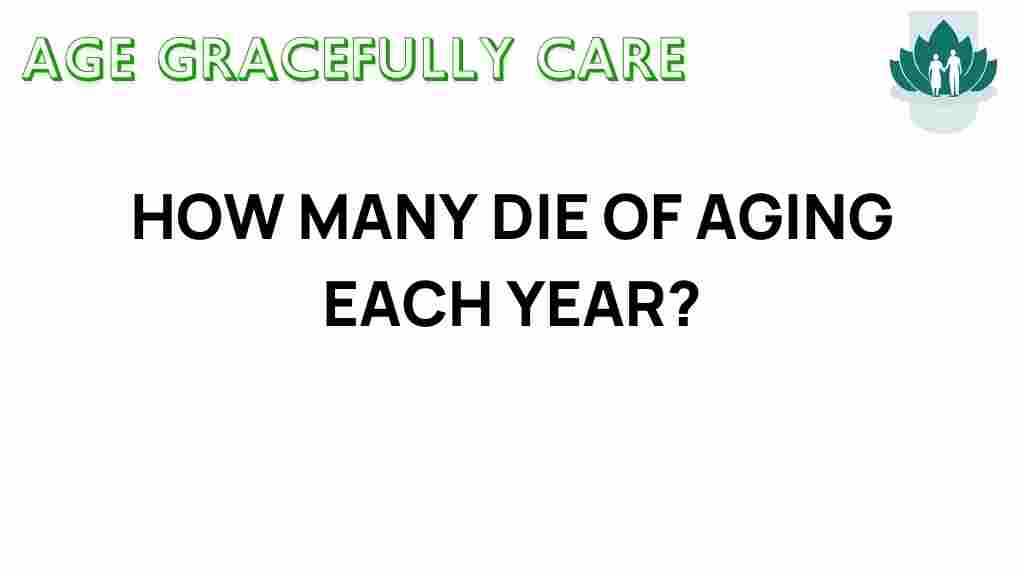The Hidden Toll: How Many Die of Aging Each Year?
Aging is a natural process that every living organism experiences, yet its ramifications on health and mortality are often underestimated. As life expectancy increases in many parts of the world, the question arises: how many people die of aging each year? Understanding the mortality rates associated with aging is crucial for public health, gerontology, and policy-making. In this article, we will delve into the hidden toll of aging, explore health statistics related to mortality, and discuss the implications for individuals and society.
Understanding Aging and Mortality
Aging is defined as the gradual process of physical, psychological, and social deterioration that occurs over time. It is influenced by a variety of factors, including genetics, lifestyle, and environmental conditions. Mortality, on the other hand, refers to the incidence of death in a population, often expressed as a rate per 1,000 individuals per year.
Life expectancy measures the average number of years a person can expect to live, and it has been steadily increasing in many countries. However, this increase in life expectancy does not always correlate with improved health outcomes. Many individuals may live longer but not necessarily healthier lives, leading to higher mortality rates associated with aging.
Health Statistics on Aging and Mortality
To understand the mortality rates associated with aging, it is essential to examine relevant health statistics:
- Global Aging Population: By 2050, it is projected that over 1.5 billion people will be aged 65 and older worldwide.
- Leading Causes of Death: Chronic diseases such as heart disease, cancer, and respiratory diseases are prevalent among older adults.
- Mortality Rates: According to the World Health Organization (WHO), the mortality rate for individuals aged 65 and older is significantly higher than that of younger populations.
- Life Expectancy Trends: In many developed countries, life expectancy has risen to over 80 years, but this does not guarantee a life free of chronic illnesses.
These statistics highlight the significance of aging in discussions about mortality and health outcomes. As our population ages, understanding the impact of aging on mortality is more critical than ever.
The Gerontology Perspective
Gerontology is the multidisciplinary study of aging and the challenges that come with it. Researchers in this field focus on the biological, psychological, and social aspects of aging. They analyze data to uncover trends in mortality and life expectancy, helping to inform public health strategies and elder care policies.
Key areas of focus in gerontology include:
- Health Promotion: Encouraging healthy lifestyles to reduce the impact of aging-related diseases.
- Preventive Care: Implementing screenings and preventative measures to catch health issues early.
- Policy Development: Advocating for policies that support the aging population, including healthcare access and social services.
By understanding the intricacies of aging, gerontologists can help mitigate the effects of mortality associated with aging.
Step-by-Step Process: Assessing the Impact of Aging on Mortality
To assess how aging contributes to mortality, we can follow a structured process:
Step 1: Data Collection
The first step involves gathering data from reliable sources such as:
- The World Health Organization (WHO)
- National health departments
- Academic journals in gerontology
- Health databases
Step 2: Analyze Mortality Rates
Once data is collected, the next step is to analyze mortality rates among different age groups, focusing on:
- Age-specific death rates
- Causes of death
- Trends over time
Step 3: Identify Risk Factors
Understanding the risk factors associated with aging can help in identifying why certain populations experience higher mortality rates. Key risk factors include:
- Chronic health conditions (e.g., diabetes, heart disease)
- Lifestyle choices (e.g., smoking, diet)
- Socioeconomic status
- Access to healthcare
Step 4: Implement Interventions
Based on the analysis, public health interventions can be designed to target the identified risk factors, such as:
- Health education programs
- Access to preventive care services
- Community support initiatives for older adults
Troubleshooting Tips: Addressing Aging-Related Mortality
While the process of assessing aging-related mortality is systematic, challenges may arise. Here are some troubleshooting tips:
- Data Limitations: If data is scarce, consider collaborating with local health organizations to gather community-specific statistics.
- Public Engagement: Engage the community in discussions about health practices to improve participation in health programs.
- Funding Challenges: Seek grants from health foundations or government programs focused on aging and health.
By tackling these challenges, we can better understand and address the toll of aging on mortality rates.
Conclusion: The Importance of Addressing Aging and Mortality
The hidden toll of aging is a pressing public health concern that requires our attention. With increasing life expectancy, more individuals are living longer, but not necessarily healthier lives. By understanding the mortality rates associated with aging, we can develop effective strategies to improve health outcomes for older adults.
As we continue to explore the fields of gerontology and public health, it is vital to prioritize research and interventions that address the unique challenges posed by an aging population. For more information on health statistics related to aging, consider visiting the World Health Organization or other reputable health resources.
Furthermore, it is essential to foster discussions within our communities about aging and its implications for mortality. By raising awareness and advocating for better healthcare policies, we can ensure that aging individuals receive the support they need to lead fulfilling, healthy lives.
In summary, while aging is an inevitable part of life, the mortality associated with it does not have to be. Through research, advocacy, and community engagement, we can work towards a future where aging is met with dignity and respect, ultimately reducing the hidden toll of mortality associated with aging.
This article is in the category Health and created by AgeGracefullyCare Team
